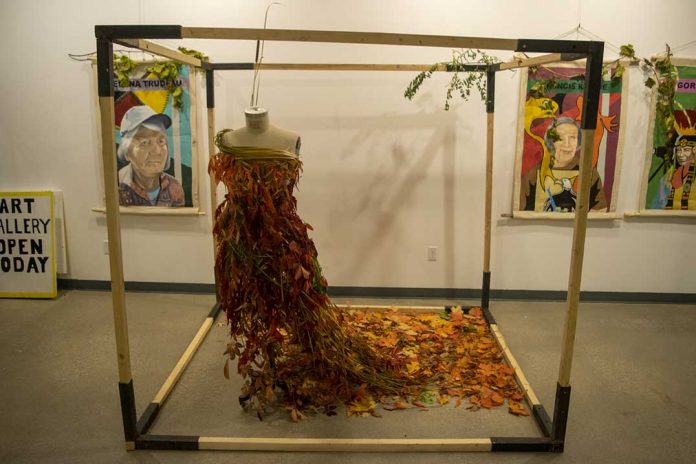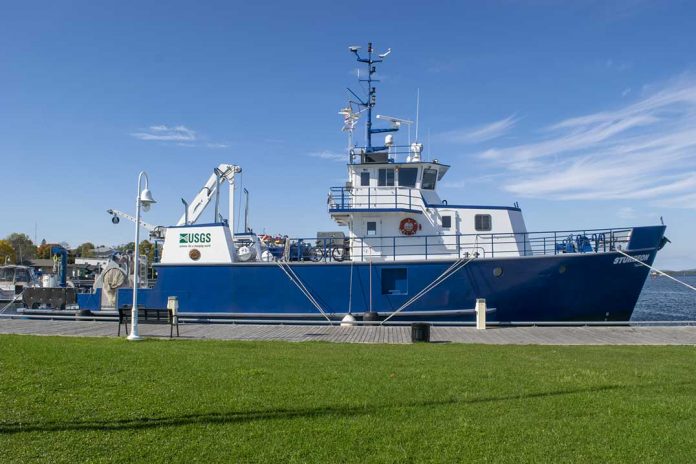NAIRN CENTRE – Drivers on westbound Highway 17 heading from Sudbury toward the Manitoulin turn-off will notice a new billboard between Nairn Centre and McKerrow that describes a Canadian law with a frank statement: “Buying sex is a crime.”
It’s a part of a campaign by Manitoulin Northshore Victim Services (MNVS) and the Manitoulin and Area Coalition Against Human Trafficking (MACEHT) to reduce human trafficking in this catchment area and offer support to trafficking victims.
“We want to let people know that there’s zero tolerance for buying sex. Our coalition collectively agrees, if there’s no demand then we won’t have the supply,” said Natasha Falle, Anti-Human-Trafficking Project co-ordinator at MNVS.
Ms. Falle proposed the 15-month project to MNVS. Through its partnership with MACEHT, the project supports training for agencies on human trafficking and how it happens, how to identify victims of human trafficking and how to respond to those while being trauma-informed in providing services.
This includes quick-reference cards to help police officers notice the signs of a human trafficking victim. There is also a prevention component of speaking to students, especially those in the high-risk age group of 13 to 16 years old.
The federal-level Protection of Communities and Exploited Persons Act, 2014, entrenched the crime of purchasing sexual services in the Criminal Code. Manitoulin-area partner organizations in this effort include Noojmowin Teg Health Centre, Wikwemikong Health Centre, M’Chigeeng Ontario Works, Manitoulin Family Resources, United Chiefs and Councils of Mnidoo Mnising, Canadian Mental Health Association, Courage for Freedom and the three police forces serving the Island.
A billboard of this nature raises questions as to the degree of the problem in the Manitoulin region. Statistics Canada noted that human trafficking is difficult to measure given its hidden nature. However, the rates of police-reported human trafficking have steadily increased from 2010 to 2016 (the date of the report) with a sharp increase between 2013 and 2015 especially.
Canadian police forces officially reported 340 cases of human trafficking in 2016. Two-thirds of the offences from 2009 to 2016 were reported in Ontario.
“These highways are part of a circuit in prostitution. Highway 17 is a part of that because it’s so close to Sudbury. If a trafficker is moving cross-country, they might make a pit stop on Manitoulin,” said Ms. Falle. “There’s very vulnerable people in the communities on Manitoulin Island and the North Shore. Traffickers know that, too. If they know that we’re not tolerating people buying sex, the hope is that it will be less likely.”
Young women make up the bulk of the victims of human trafficking. Collectively, people of all genders younger than 25 years old make up 72 percent of victims. Women comprised 70 of the percentage points in that figure.
Ms. Falle added that 55 percent of the girls who are trafficked are Indigenous. Only five percent of females in Canada identify as Indigenous according to 2016 Statistics Canada census data, making the rate of their victimization in human trafficking 11 times greater than their proportionate population.
Ms. Falle said she expected the number of victims coming forward to report their circumstances would increase. She helped co-ordinate a similar project in Fort Frances, a place where few thought they had a trafficking problem until the project began and people began to disclose their victimization.
“Once we started educating them on the topic, they started realizing where they may have missed opportunities to help women and girls, though it happens to boys and men, too,” she said, adding that she had previously done some in-school speaking engagements for MNVS as a human trafficking survivor and had heard some disclosures.
“Once you’ve experienced this level of trauma, it really stays with you for life and affects every area of your life,” said Ms. Falle. “Eighty-five percent of trafficking victims return to prostitution or trafficking (after they leave that life), or even return to the same trafficker as before.”
A significant reason why this is such a difficult cycle to break is because of the ways victims are conditioned and brainwashed by traffickers. If they are taken into the circuit at a young age, victims tend to lack a lot of the emotional intelligence that is required to thrive in the ‘outside’ world.
“You might be really confident in that life but when you’re taken out of it, you may feel like you don’t have communication skills. You don’t know who you are when you leave,” said Ms. Falle. “(Traffickers) make you believe they give you life; you eat, breathe and sleep for the traffickers. They say your ‘family’ in the sex trade are the only ones who don’t judge you and so when you’re out of that environment you’re constantly looking for judgment.”
She added that business and personal relationships vary widely in different circumstances, with some victims having personal relationships with their traffickers, some having children with them, some splitting revenues 50/50 and others giving all the money to their traffickers.
“Some traffickers may, in some twisted way, take care of their people. Others do what we call gorilla (also called guerilla) pimping, which is like ‘you belong to me, you’re my property,’” said Ms. Falle.
A trafficker’s set of victims is referred to as a “stable.” Ms. Falle said the ones that a trafficker controls most closely are called “mains” or “bottoms,” and often become just like the abuser and will start to recruit victims for the trafficker or hold onto funds on their behalf, possibly even taking the fall on any criminal charges to protect the trafficker.
Ms. Falle stressed that while notions of human trafficking and coerced sex work may conjure mental images of physical restraints, most trafficking victims appear free and can physically leave the environment at their will. However, they are deeply mentally conditioned into staying with an abuser.
“We don’t leave because of invisible captivity and psychological abuse. We’re led to believe our only worth is to be bought and sold,” said Ms. Falle, who said that the general population is beginning to get a better perception of the meaning of the phrase ‘human trafficking.’
That has also sparked a shift away from a long history of when society would blame sex trafficking victims as criminals and deviants, a mindset that is still somewhat common in the public but is not representative of modern laws. This has created more opportunities for “an out” than ever before, according to Ms. Falle.
“If you suspect somebody is a victim, you have to respond on an individual basis,” said Ms. Falle, who cautioned against putting oneself in a dangerous situation through a ‘rescue mentality’ and instead being there to provide unconditional, non-judgmental support.
“It’s about bringing back sensitivity when they’ve been so desensitized. (Victims) get so used to the violence that they don’t really notice it any more. Let them know you’re afraid and worried for them,” said Ms. Falle, who said that if someone suspects they know a victim, it is much better to be direct and ask rather than trying to indirectly approach the subject to avoid offending them.
Manitoulin Northshore Victim Services provides supports to victims of human trafficking.
“We have people who have experienced what they have, who will approach it in a non-judgmental way and work at their pace. We understand getting out might not happen overnight and we will meet them where they’re at,” said Ms. Falle.
The organization also provides urgent services if needed.
“We can get a victim to safety in 20 minutes if they call Victim Services,” said Ms. Falle.
MNVS can be reached by calling 1-866-392-7733 or visiting its website at MNVictimServices.ca.





